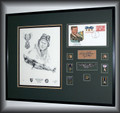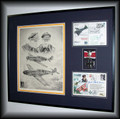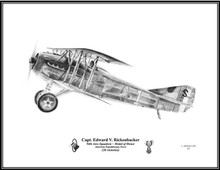 Loading... Please wait...
Loading... Please wait...Categories
Our Newsletter
- Home
- Combat Aircraft/Pencil Drawings ~ Free Shipping
- French ~ SPAD XIII (Capt. "Eddie" Rickenbacker) ~ Free Shipping
Product Description
***CLICK ON IMAGE TO ENLARGE***
Print Size 8½ x 11 ----- Unlimited print editionSPAD VII & XIII
There can be no question that the SPAD scouts were the most successful French fighter aircraft of World War I. Indeed, many would say (and not only Frenchmen) that the SPAD was the flnest fighter produced by any nation at that time. Yet, like so many great airplanes, the SPAD twins, the Vll and the Xlll, had relatively humble beginnings. Before the war the Deperdussin company's brilliant young designer, Louis Bechereau, designed a sleek, braced wing monoplane with an ultra-streamlined fuselage, Known as the Monocoque, because of its fuselage construction, the Deperdussin was planned from the outset to go fast, lt did. ln its first year, 19 12, it won the Gordon Bennett Cup with a speed of l73.97km/h and the following year the Deperdussin racer captured the world air-speed record at 204 km/h. Powering this stubby, but sleek little racer was a Gnome l4-cylinder rotary engine. The full name of the original Deperdussin company was the Societe des Produclions Armand Deperdussin, hence the name SPAD. Later, the company name was changed, but in such a way that the acronym SPAD could be retained. However, the first aircraft to use the name hardly distinguished themselves. The A2 and A4 rejoiced in one of the most unconventional - and least successful - configurations in aviation history, They were tractor aircraft (i.e. the propeller was at the nose of the airplane and pulled it forward) but the observer/gunner was seated in front of the propeller, This arrangement was hardly popular with the crew but the idea was to get over the problem of firing through the propeller. lt was a freakish design and it didn't last. ln April 1916, the SPAD Vll arrived. Designed by Bechereau, it was a conventional biplane in appearance,but it was immediately apparent that it could outperform the Nieuports that were then supplying the main fighter strength for the French Aviation Militaire. lt was also a much stronger aircraft all round. The first contract was awarded in the spring of 1916. Production started almost immediately and SPAD Vlls began to be delivered in September. The SPAD Vll was powered by Marc Birkigt's marvellous new Hispano-Suiza water-cooled V8 engine which developed l50hp. Armament was a single 7.65mm Vickers offset to the right, using Birkigt synchronizing gear (no need to sit in front of the propeller now!). Fuel was carried under the lower wing in a fuselage tank specially curved to conform with the sleek fuselage lines, and a notable first for the SPAD Vll was the fact that this fuel could be lettisoned in an emergency. One of the very first SPAD Vlls to enter service was delivered to a 2l-year-old lieutenant inlhe Escadrtlle de Chasse N3. His name was Georges Guynemer. The fact that he claimed a victim on his second flight with the SPAD was remarkable; what was more unusual was that he shot down another three on a sortie only a few days later. However, this sad-looking young lieutenant was unusual. By the end of January, his total aircraft kills had reached 30, and because of this he christened his beloved SPAD La Mitrailleuse Volante, the Flying Machine Gun. Georges Guynemer flew in good company. His fellow pilots in Escadrille N3 - the renamed SPAD but always known as Les Cigognes, or The Storks - included such aces as Capitaine Armand Pinsard (with 27 victories), Sous-Lieutenant Rene Dorme (with 23), Capitaine Alfred Herlaux (with 2l) and Capitaine Albert Deullin (with 20). The SPAD Vll was so successful during this period that the other Allies all clamoured to use it. Many companies began to manufacture the Vll under licence, including two British-based companies, the British Bleriot and Spad Company at Brooklands and Mann Egerton in Norwich. Most of these British-built SPADs never found their way to the Western Front, Nevertheless, the SPAD served with great distinction in the Middle East, Belgium and ltaly, where Maggiore (Major) Francesco Baracca of the Gia Squadriglia achieved 23 of his 34 victories in SPADs, before he was killed in action on June l9,l9l8. However back in the spring of 1917, a new SPAD was demonstrated to the Fscadrilles de Chas{e. The SPAD Xlll was fltted with a more powerful Hispano-Suiza V8 engine which delivered 200hp. lt also carried two Vickers 7.65mm guns mounted above the engine. Georges Guynemer took delivery of one of these aircraft during the summer. His inevitable toll of victories seemed set to continue, but on I I September 1917 he disappeared while on a patrol over Poelcapelle, The great French ace of the war had claimed his last victim, with an amazing total of 54 confirmed kills. But as always, someone was ready to take his place. Rene Fonck, who was by now also flying a SPAD Xlll, had already shot down over 30 German aircraft, He went on to achieve a total score of 75 victories, makrng him the leading Allied ace, Eleven of his kills were gained with a SPAD fltted with a 37mm. cannon, firing through the hub of the propeller. Guynemer gained four victories with a similar aircraft. By March l9l 8, after Birkigt had made some hurried improvements to the new engine, which had proved somewhat unreliable, SPADs were being turned out at a remarkable rate and in fact, total French production of the aircraft reached 8472 by the time it stopped in l9l9. Around 14,700 were manufactured in total, outnumbering all other World War I flghters, American interest in the SPAD was spearheaded by the successes of their two great aces, Eddie Rickenbacker and Frank Luke. Rickenbacker scored the majority of his 26 victories in the SPADXIII, and the good reports he and his fellow Amcricans sent back resulted in the ambitious decision to build no less than 6000 SPADs in the United States.
The Armistice, of course, intervened in 1918. Notwrthstanding, the two SPAD's overall contribution to the Allies' fortunes cannot be overstated. They rank, along with the SE5 and the Camel, as the greatest Allied fighters of the entire war.
Warranty Information
null








